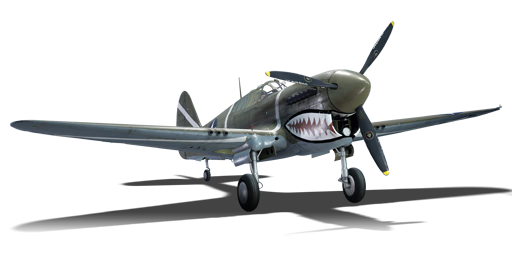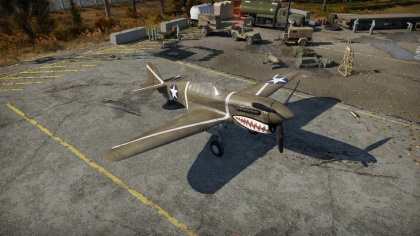Difference between revisions of "P-40F-10"
(Restored page from version archived 12-01-19.) |
m (Tag: Visual edit) |
||
| Line 131: | Line 131: | ||
=== Survivability and armour === | === Survivability and armour === | ||
<!-- Examine the survivability of the aircraft. Note how vulnerable the structure is and how secure the pilot is, whether the fuel tanks are armoured. Describe the armour, if there is any, also mention the vulnerability of other critical aircraft systems. --> | <!-- Examine the survivability of the aircraft. Note how vulnerable the structure is and how secure the pilot is, whether the fuel tanks are armoured. Describe the armour, if there is any, also mention the vulnerability of other critical aircraft systems. --> | ||
| + | |||
* 38 mm Bulletproof glass in front of pilot. | * 38 mm Bulletproof glass in front of pilot. | ||
* 3 mm Steel plate in front of oil cooling system. | * 3 mm Steel plate in front of oil cooling system. | ||
| Line 182: | Line 183: | ||
===Modules=== | ===Modules=== | ||
{| class="wikitable" | {| class="wikitable" | ||
| − | !colspan = "1"| Tier | + | ! colspan="1" | Tier |
| − | !colspan = "2"| Flight performance | + | ! colspan="2" | Flight performance |
| − | !colspan = "1"| Survivability | + | ! colspan="1" | Survivability |
| − | !colspan = "2"| Weaponry | + | ! colspan="2" | Weaponry |
|- | |- | ||
| I | | I | ||
| Line 202: | Line 203: | ||
|- | |- | ||
| III | | III | ||
| + | |Wings Repair | ||
| + | |Engine | ||
| + | | | ||
| + | |New 12 mm MGs | ||
| + | | | ||
| + | |- | ||
| + | | IV | ||
| | | | ||
| Engine Injection | | Engine Injection | ||
| Line 207: | Line 215: | ||
| | | | ||
| FMBC mk.1 | | FMBC mk.1 | ||
| − | |||
| − | |||
| − | |||
| − | |||
| − | |||
| − | |||
| − | |||
|- | |- | ||
|} | |} | ||
Revision as of 15:55, 6 April 2019
Contents
| This page is about the aircraft P-40F-10. For other uses, see P-40 (Disambiguation) |
Description
The P-40F-10 Warhawk is a Rank II American fighter
with a battle rating of 2.3 (AB) and 2.7 (RB/SB). It was introduced in Update 1.79 "Project X".
General info
Flight Performance
| Characteristics | |||||||
|---|---|---|---|---|---|---|---|
| Stock | |||||||
| Max Speed (km/h at 5,029 m) |
Max altitude (meters) |
Turn time (seconds) |
Rate of climb (meters/second) |
Take-off run (meters) | |||
| AB | RB | AB | RB | AB | RB | ||
| 584 | 568 | 11000 | 21.5 | 22.0 | 6.1 | 6.1 | 350 |
| Upgraded | |||||||
| Max Speed (km/h at 5,029 m) |
Max altitude (meters) | Turn time (seconds) | Rate of climb (meters/second) |
Take-off run (meters) | |||
| AB | RB | AB | RB | AB | RB | ||
| 646 | 615 | 11000 | 18.7 | 20.0 | 17.3 | 9.6 | 350 |
Details
| Features | ||||
|---|---|---|---|---|
| Combat flap | Take-off flap | Landing flap | Air brakes | Arrestor gear |
| ✓ | ✓ | ✓ | X | X |
| Limits | ||||
|---|---|---|---|---|
| Wing-break speed (km/h) |
Gear limit (km/h) |
Combat flap (km/h) |
Max Static G | |
| + | - | |||
| 0 | 300 | 645 | ~?? | ~? |
| Optimal velocities | |||
|---|---|---|---|
| Ailerons (km/h) |
Rudder (km/h) |
Elevators (km/h) |
Radiator (km/h) |
| < 420 | < 380 | < 420 | > 340 |
| Compressor (RB/SB) | ||
|---|---|---|
| Setting 1 | ||
| Optimal altitude | 100% Engine power | WEP Engine power |
| 3,733 m | 1,260 hp | 1,584 hp |
| Setting 2 | ||
| Optimal altitude | 100% Engine power | WEP Engine power |
| 6,400 m | 1,175 hp | 1,477 hp |
Survivability and armour
- 38 mm Bulletproof glass in front of pilot.
- 3 mm Steel plate in front of oil cooling system.
- 8 mm Steel plate behind the pilot.
Armaments
Offensive armament
The P-40F-10 is armed with:
- 6 x 12.7 mm M2 Browning machine guns, wing-mounted (281 rpg = 1,686 total)
Suspended armament
The P-40F-10 can be outfitted with the following ordinance"
- Without load
- 2 x 100 lb AN-M30A1 bombs
- 1 x 500 lb AN-M64A1 bombs
- 1 x 500 lb AN-M64A1 bombs + 2 x 100 lb AN-M30A1 bombs
Usage in battles
Describe the tactics of playing in an aircraft, the features of using vehicles in a team and advice on tactics. Refrain from creating a "guide" - do not impose a single point of view, but give the reader food for thought. Examine the most dangerous enemies and give recommendations on fighting them. If necessary, note the specifics of the game in different modes (AB, RB, SB).
Manual Engine Control
| MEC elements | ||||||
|---|---|---|---|---|---|---|
| Mixer | Pitch | Radiator | Supercharger | Turbocharger | ||
| Oil | Water | Type | ||||
| Controllable | Not controllable | Not controllable | Controllable | Combined | Controllable | Not controllable |
Modules
| Tier | Flight performance | Survivability | Weaponry | ||
|---|---|---|---|---|---|
| I | Fuselage Repair | Radiator | Offensive 12 mm | ||
| II | Compressor | Airframe | FSBC mk.1 | ||
| III | Wings Repair | Engine | New 12 mm MGs | ||
| IV | Engine Injection | Cover | FMBC mk.1 | ||
Pros and cons
Pros:
- Good survive-ability
- Good energy retention in a dive
Cons:
- Engine prone to overheating
- Like the previous iteration of the P-40, does not do well in a turn fight
History
Although early P-40s were equipped with one of the most powerful inline engines available to the American aircraft industry at the time, it quickly became apparent that even that wasn’t enough. Due to its advanced and robust design, it’s no secret that the P-40 was a relatively heavy aircraft for its type, resulting in power-to-weight issues which would never be fully solved. Nonetheless, Curtiss engineers continued tweaking and improving the design in all aspects, trying to lessen the drawbacks of a high weight and insufficient power.
In 1940, the American Packard Motor Car Company acquired a licence to manufacture the Rolls-Royce Merlin engine, in an effort to satisfy the growing demand of the British aviation industry. Additionally, the licence gave American engineers access to a more powerful engine at a time where similar U.S. engines were not available. Naturally, Curtiss engineers didn’t waste any time outfitting the P-40 with the brand new licence-built Merlin engine, resulting in the creation of the P-40F. Besides the internal engine upgrade, some external changes were also applied to the aircraft. For instance, the tail section of the fuselage was lengthened in an effort to counter the negative effects of strong engine torque on take-off and landing experienced on earlier modifications. With the changes applied, serial production of the new P-40F was scheduled to begin in 1942. As the British and Commonwealth air forces were particularly keen on a Merlin-engined P-40 variant, they were also the first ones to receive the new P-40Fs as early as summer of the same year.
Despite the British and Commonwealth forces receiving the P-40Fs first, the majority of the 1,300 manufactured machines served with units of the USAAF in the Mediterranean theatre. By the end of the Mediterranean campaign in late 1943, the P-40F had successfully proven the value of the applied changes by presenting itself as a more than capable air superiority fighter, when matched up against previously superior Axis counterparts such as the Bf 109F/G and M.C. 202/205. During its service in the Mediterranean, experienced pilots, applying the right tactics showed that the Warhawk could no longer be considered the underdog, but instead an equal at very least.
Interesting: The Soviet Union received P-40 fighters under the lend-lease program; they were considered to be aircraft with medium efficiency but were quite durable. Lieutenant Alexei Khlobystov in one battle conducted two successful rams and after that encounter, the pilot and his “Kittyhawk” returned to the airfield!
- From Devblog
Media
An excellent addition to the article will be video guides, as well as screenshots from the game and photos.
See also
Links to the articles on the War Thunder Wiki that you think will be useful for the reader, for example:
- reference to the series of the aircraft;
- links to approximate analogues of other nations and research trees.
External links
| USA fighters | |
|---|---|
| P-26 Peashooter | P-26A-33 · P-26A-34 · P-26A-34 M2 · P-26B-35 |
| P-36 Hawk | P-36A · Rasmussen's P-36A · P-36C · ○P-36C · P-36G |
| P-39 Airacobra | P-400 · P-39N-0 · P-39Q-5 |
| P-40 | P-40C · P-40E-1 · P-40E-1 TD · P-40F-10 |
| P-43 Lancer | P-43A-1 |
| P-47 Thunderbolt | P-47D-22-RE · P-47D-25 · P-47D-28 · P-47M-1-RE · ⋠P-47M-1-RE · P-47N-15 |
| P-51 Mustang | P-51 · P-51A (Thunder League) · P-51C-10 · P-51D-5 · P-51D-10 · P-51D-20-NA · P-51D-30 · P-51H-5-NA |
| P-63 Kingcobra | P-63A-5 · P-63A-10 · P-63C-5 · ␠Kingcobra |
| Prototypes | XP-55 |
| F2A Buffalo | F2A-1 · Thach's F2A-1 · F2A-3 |
| BF2C | BF2C-1 |
| F3F | F3F-2 · Galer's F3F-2 |
| F4F Wildcat | F4F-3 · F4F-4 |
| F4U Corsair | F4U-1A · F4U-1A (USMC) · F4U-1D · F4U-1C · F4U-4 · F4U-4B · F4U-4B VMF-214 · F2G-1 |
| F6F Hellcat | F6F-5 · F6F-5N |
| F8F Bearcat | F8F-1 · F8F-1B |
| Other countries | ▃Ki-43-II · ▃Ki-61-Ib · ▃A6M2 · ▃Bf 109 F-4 · ▃Fw 190 A-8 · ▃Spitfire LF Mk IXc |





